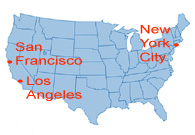A survey, which is believed to be the first of its kind to assess Asian same-sex households in New York City, Los Angeles and San Francisco found 19,213 Asian or Pacific Islander same-sex households in 2000, accounting for 0.5 percent of Asian households and 0.9 percent of Pacific Islander households.

The report, which is the first publicly accessible report with socio-economic details on Asian gays and lesbians in the U.S., is available on http://www.aafny.org/cic/.
The Asian American Federation of New York, which was selected by the U.S. Census Bureau to operate the only Census Information Center (CIC) in the New York metropolitan area focused on serving the Asian American community, found that 17,163 Asians identified themselves as the head of a same-sex household.
The vast majority of the households surveyed in the three cities were made up of immigrants to the United States, most of whom had entered the country in 1980 or later. Eighty-three percent of Asians in same-sex households live in Los Angeles, 81 percent in New York and 73 percent in San Francisco.
The study also showed that children were more likely to live in same-sex Asian households than in non-Asian same-sex households. Forty-four percent of same-sex Asian households in Los Angeles and 43 percent in New York have children in them, compared with 32 percent in Los Angeles and 27 percent in New York for non-Asian same-sex couples. The report however did not distinguish between siblings and children of the respondents.
Other major findings include:
- Chinese Americans were the largest ethnic group among Asian same-sex households with 22 percent (or 3,772) of gay and lesbian partner households, followed by Filipinos, Indians, Japanese and Koreans while Native Hawaiians were the largest ethnic group among Pacific Islander same-sex households with 40 percent (or 386 households).
- Same-race relationships predominated among Asian same-sex households, but to divergent degrees in different metropolitan areas. Percentages of Asians living with other Asians varied from 56 percent in San Francisco to 74 percent in New York. Asian/White was the most common combination for interracial partnerships.
- Median household incomes for Asian same-sex households generally were higher than Asian opposite-sex households but lower than for non-Asian same-sex households. For example, in New York, median income for Asian gay and lesbian households was US$55,500 a year, compared with US$69,300 for non-Asian same-sex households and US$48,600 for Asian opposite-sex partners.
- Within the Asian same-sex population, gay partners earned considerably more than lesbian partners. The widest variation occurred in Los Angeles, where the median income for male households was US$81,000 - 56 percent more than US$51,900 for female households.
- Language barriers were higher for Asian same-sex partners than for non-Asian gays and lesbians. The incidence of "Limited English Proficiency" (defined as speaking English "not well" or "not at all") for Asian gay and lesbian partners was as high as 23 percent, in Los Angeles, where 13 percent of non-Asian same-sex partners fit this category. Among same-sex partners in New York and San Francisco, limited English ability was more than twice as common for Asians as for non-Asians.
- Asian gay and lesbian partners had less education than non-Asian same-sex partners in New York and San Francisco. For instance, among same-sex partners in New York, 26 percent of Asians (compared with 18 percent of non-Asians) lacked a high school diploma, while 39 percent of Asians (short of 43 percent of non-Asians) had higher education.
- Asian lesbian partners were more likely than gay partners to have children living with them in New York and San Francisco. In New York, children lived in 62 percent of female homes - more than twice the frequency of 30 percent of male households. Los Angeles presented the opposite pattern, with children in 45 percent of gay households and 42 percent of lesbian homes.
The Asian American Federation of New York is a non-profit leadership organisation that works collaboratively to meet the critical needs of Asian Americans in the New York metropolitan area. Operating since 1990, the Federation strengthens community-based health and social services capacity by supporting its 35 member agencies and other grassroots organisations.
